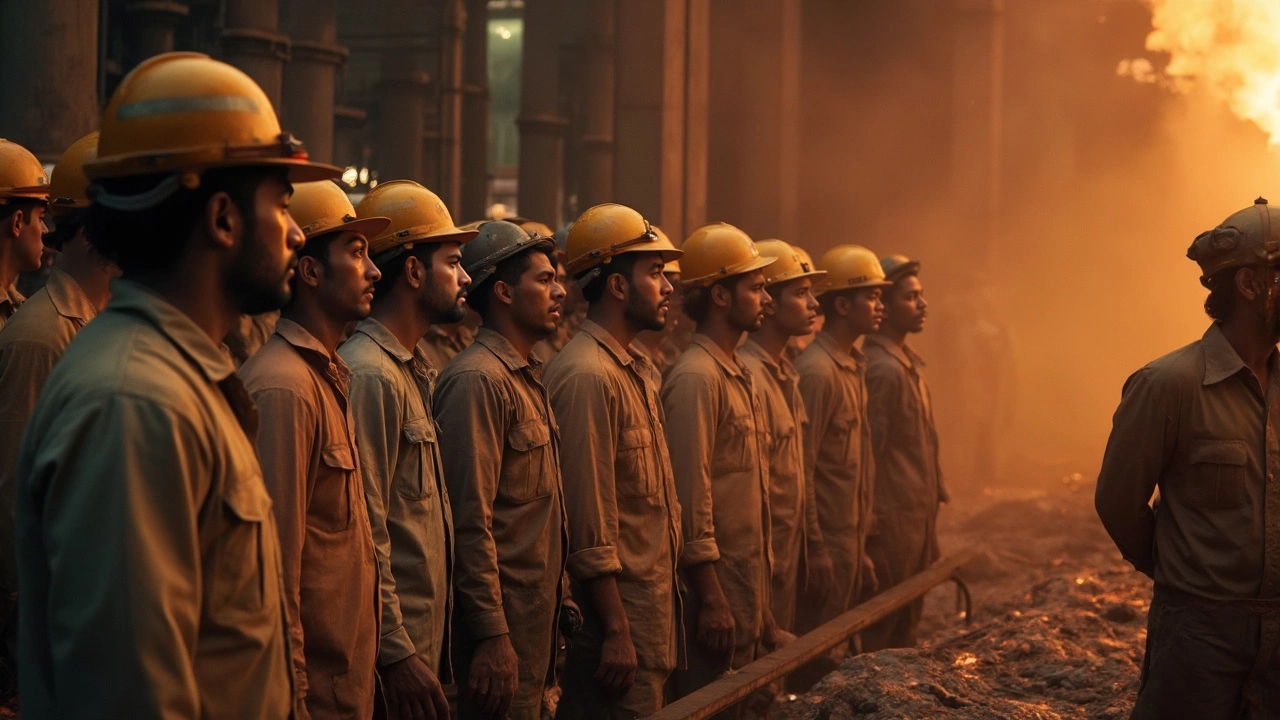Who Wants to Buy U.S. Steel? All Eyes on the Big Deal

The steel industry might sound old-school, but lately, it’s been grabbing headlines again. Everyone’s buzzing about the big question: which company is actually trying to buy U.S. Steel right now? The answer is straight—Japan’s Nippon Steel is at the center of the action. Back in late 2023, Nippon Steel made a splash by announcing a huge $14.1 billion deal to acquire U.S. Steel, an iconic name that’s been part of America’s backbone for over a century.
This isn’t just some boring business deal. If it goes through, it’ll be one of the biggest foreign takeovers in U.S. manufacturing in years. Thousands of workers are watching, wondering how this buyout could affect their jobs. The rumor mill keeps turning, but here’s what’s real: Nippon Steel wants U.S. Steel’s plants, people, and place in American industry. The story is still unfolding, but you need to know who’s involved, what’s at stake, and how it might hit your wallet or hometown.
- The Big Bid: Who’s Making a Move on U.S. Steel?
- Why Nippon Steel Wants In
- What This Means for U.S. Steel and Its Workers
- Obstacles: Politics, Protests, and Policy
- What Happens Next for U.S. Steel Plants?
The Big Bid: Who’s Making a Move on U.S. Steel?
Let’s break it down. In December 2023, Nippon Steel, Japan’s biggest steelmaker, threw down a massive $14.1 billion bid to buy U.S. Steel. This wasn’t out of the blue—U.S. Steel had already been looking for offers after getting interest from different companies. But Nippon Steel’s offer was way above the rest, grabbing everyone’s attention, from Wall Street to small towns built around steel plants.
Here are the main details everyone’s talking about:
- Nippon Steel’s bid is all-cash—no complicated stocks or mergers.
- U.S. Steel’s board quickly backed the offer, saying it gave more value to shareholders than any other deal on the table.
- Other companies tried to get in. Cleveland-Cliffs, a big name in American steel, made a public bid before, but it didn’t match Nippon’s dollars.
This deal doesn’t just matter to investors. If the sale goes through, U.S. Steel switches from American to Japanese ownership for the first time. That’s huge—especially for an industry so tied to American history and jobs.
The numbers tell the story:
| Company | Bid Amount | Type of Deal | Status as of May 2025 |
|---|---|---|---|
| Nippon Steel | $14.1 billion | Cash Buyout | Pending (Facing Regulatory Review) |
| Cleveland-Cliffs | About $12.8 billion | Cash and Stock | Rejected |
| ArcelorMittal | Rumored Offer | Not Disclosed | No Public Bid |
So, who’s really trying to buy U.S. Steel? It’s Nippon Steel, and they’re not messing around. Their move has already shaken up the whole U.S. Steel business, sparked political debates, and got unions talking. People want to know—will this reshape the U.S. steel industry for good?
Why Nippon Steel Wants In
Nippon Steel isn’t making this play just for bragging rights. The Japanese company is looking for a concrete edge—both in the U.S. and globally. First, the American market is still one of the biggest for steel, and U.S. Steel is the third largest steelmaker in the country, right behind Cleveland-Cliffs and Nucor. Buying U.S. Steel jumps Nippon straight into the heart of the U.S. supply chain, which is a huge deal now that companies want more "Made in America" products.
This deal is all about being closer to major U.S. customers. Car companies, construction firms, and appliance brands still need mountains of steel. Nippon can tap directly into these buyers without exporting across the Pacific, saving money and time. They also get access to U.S. Steel’s advanced tech, like electric arc furnaces, which are cleaner than old-school steelmaking.
- U.S. Steel already has established relationships with U.S. auto giants like Ford and General Motors.
- Getting inside the American market hedges against shaky trade relations and tariffs that make exporting expensive.
- Nippon Steel can also experiment with new products on U.S. soil before rolling them out worldwide.
Bottom line: This isn’t just about expanding for the sake of it. Nippon Steel is betting that a strong base in the U.S. will help them stay ahead as global steel markets get more competitive and technology keeps changing how steel is made and sold.

What This Means for U.S. Steel and Its Workers
If you’re working at U.S. Steel or know someone who is, it’s natural to feel uneasy with all this takeover talk. Nippon Steel promises not to close any plants or cut jobs—for now. Their official word is business as usual, but let’s be real, everyone’s watching closely. U.S. Steel has about 22,700 employees, and most are based in the U.S., mainly in Pennsylvania, Indiana, and Alabama.
The steelworkers’ union (USW) has a big say in what goes down. When news of the sale first dropped, the USW said flat-out they were blindsided. They’ve pushed back hard, even calling for U.S. regulators to step in. As of spring 2025, union leaders are still meeting with government officials to protect workers’ contracts, healthcare, and pensions.
Another big worry is if foreign ownership will shift decision-making far from U.S. communities. Plant managers, foremen, and everyone on the line are asking the same thing: Will Nippon Steel keep their word, or start making changes once the attention dies down?
| Plant Location | Employees (approx.) | Status After Deal (promised) |
|---|---|---|
| Pennsylvania (Mon Valley) | 3,500 | No closure |
| Indiana (Gary Works) | 4,800 | No closure |
| Alabama (Fairfield Works) | 1,200 | No closure |
| Other U.S. Locations | 7,200 | No closure |
If you’re worried about your future at U.S. Steel, the only practical move is to keep an eye on negotiations. The union hotline and updates are a lifeline for the latest news. Anyone thinking about training or certification might want to update their résumé—it’s never a bad time to get prepared, just in case.
The upside? Nippon Steel says they’ll invest in next-gen technology. That could bring in more automation and modern equipment, which might mean new roles, but also some job changes. For workers, the big thing is whether those investments create new jobs or just mean doing the same with fewer people.
U.S. Steel isn’t just a company—these plants are local anchors. What happens next will shape not only paychecks but entire communities.
Obstacles: Politics, Protests, and Policy
A deal as big as Nippon Steel trying to buy U.S. Steel never comes easy. The road’s been bumpy, filled with politicians, unions, and regulators all voicing concerns. There’s serious pushback from both workers on the ground and officials in D.C. who are questioning if a foreign takeover puts American industry and jobs at risk.
On Capitol Hill, several senators quickly spoke out, calling for a full review under U.S. national security laws. The United Steelworkers union (USW), which represents most of U.S. Steel’s workers, has been especially vocal. They argue that foreign ownership could mean job losses or site closures in the long run. Here’s a quote from USW International President David McCall:
"This proposed acquisition is a threat to America’s industrial future and could endanger thousands of union jobs. We’re urging the government to closely scrutinize every detail."
Besides labor concerns, there’s a real political spotlight. The Biden administration confirmed early in 2024 that the deal is being reviewed by the Committee on Foreign Investment in the United States (CFIUS). This committee can actually block deals if they’re seen as risky for national security. Local officials from steel towns like Pittsburgh have held rallies and sent petitions, pushing the White House to step in and keep U.S. Steel American-owned.
It’s not just talk—just look at the facts:
| Obstacle | Details |
|---|---|
| Labor Protests | Multiple rallies in Pennsylvania, Michigan, and Indiana since Jan 2024 |
| Regulatory Review | CFIUS investigation started Feb 2024; still ongoing in May 2025 |
| Political Pressure | Bipartisan lawmakers urging Biden to block the deal |
The U.S. Steel buyout is now tied up with broader debates about keeping key industries in American hands and protecting jobs, especially during an election year. Anyone tracking this deal should pay attention to how government agencies and local leaders shape what happens next.

What Happens Next for U.S. Steel Plants?
With Nippon Steel pushing to buy U.S. Steel, plant workers and communities are more anxious than ever. Everyone's asking: Will the mills keep running, or is job security about to take a hit? As of now, Nippon has said publicly they plan to keep all of U.S. Steel’s U.S. plants up and running, including key sites in Pennsylvania, Ohio, and Indiana.
But going forward, a lot depends on what happens behind the scenes. Here are the big points to watch:
- U.S. Steel plants are expected to keep current operations stable at least in the short term. Nippon Steel announced it wants to preserve jobs and maintain existing union agreements.
- The deal still needs to get the green light from U.S. government agencies like the Committee on Foreign Investment in the United States (CFIUS). Any rejection from regulators could send plans back to square one.
- If the sale does go through, updates to equipment and tech are likely. Nippon is known for using cutting-edge steelmaking tech, so you might see investments in electric arc furnaces and upgrades to plant safety.
- In recent years, U.S. Steel plants have battled high costs and old equipment. A cash injection from a bigger company like Nippon could give local mills a boost—but it also comes with pressure to run leaner and more efficiently.
How many workers are we talking about? Check the numbers:
| Plant Location | Employees | Main Products |
|---|---|---|
| Gary Works, IN | ~4,800 | Sheet steel, slabs |
| Mon Valley, PA | ~2,700 | Sheet, tin, plate |
| Great Lakes, MI | ~1,800 | Hot-rolled, cold-rolled |
Tip for those working at these plants: Stay in the loop with your union rep and don’t ignore updates from management. Change moves fast after these big deals, so pay attention to any notices about plant meetings, benefits, or job training—these can hit your paycheck and work life overnight. If you’re considering upskilling, keep an eye open for new tech and equipment training that Nippon might bring in.
The next six months will be crucial. Most signs point to the plants staying busy, but it’s the perfect time to stay alert and keep your résumé fresh—just in case the winds shift.